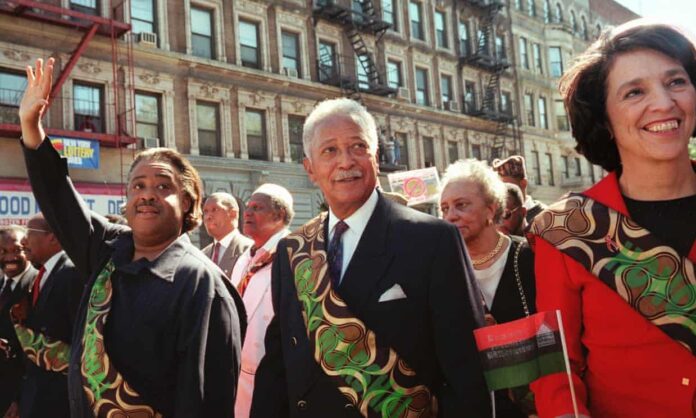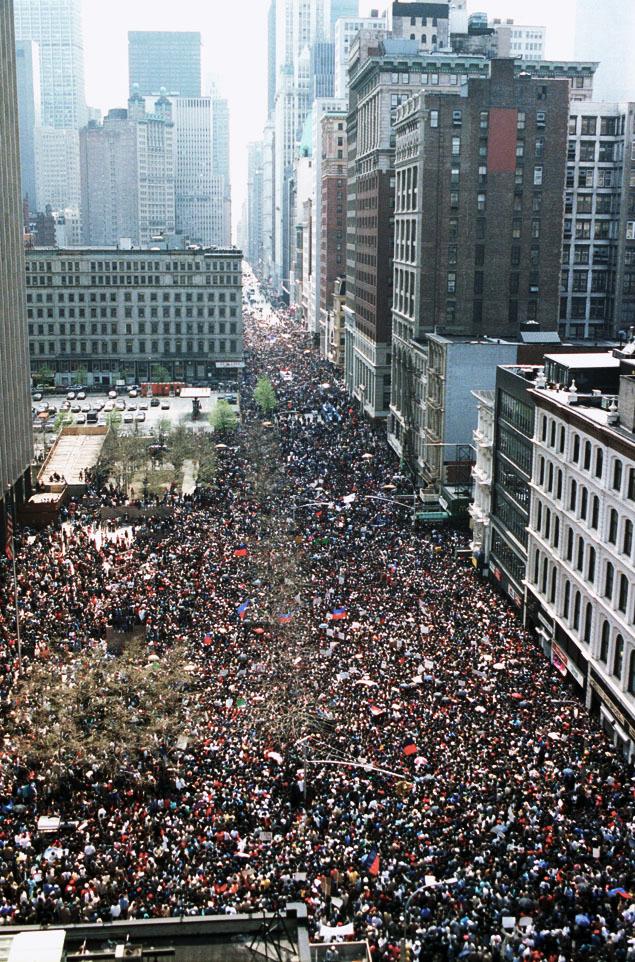
David Dinkins, New York City’s first and only black mayor, died at his Manhattan home on Nov. 23, 2020 of natural causes at the age of 93. His wife, Joyce, whom he had married in 1953, died about a month earlier.
Born on Oct. 10, 1927 in Trenton, NJ, Dinkins graduated from Trenton Central High School, served in the U.S. Marines, attended Howard University and then Brooklyn Law School. He became Manhattan Borough President in 1986 but was then drafted to be the Democratic Party’s mayoral candidate in the 1989 election against Republican Rudolph Giuliani.
Many obituaries have lauded his dignified governing style and beginning the city’s financial turnaround, although he served only one tumultuous term from Jan. 1, 1990 to Dec. 31, 1993. But most accounts leave out the special relationship Mayor Dinkins had with New York’s Haitian community.
Mayor David Dinkins had a special relationship with New York’s Haitian community.
His first test began less than three weeks after taking office when, on Jan. 18, 1990, shopper Giselaine Fétissainte, a 46-year-old Haitian home attendant, had a fight with the Korean owners of the Family Red Apple grocery store at 1823 Church Ave. in Brooklyn’s Flatbush neighborhood. She left the store in an ambulance, and the incident sparked a bitter year-long boycott of Korean-owned stores on Church Avenue, which were regularly harangued and picketed by large boisterous protests led mostly by black nationalist activist Robert “Sonny” Carson.
Dinkins tried to mediate the dispute, going to shop at Church Avenue’s Korean-owned produce stores on Sep. 21, 1990. The gesture failed to bring immediate peace, although the boycott died down over the following three months.
“I was criticized for not crossing the picket line and ending the boycott by example,” Dinkins wrote in his memoir, A Mayor’s Life: Governing New York’s Gorgeous Mosaic. “I was prepared to mediate the dispute, but I suspected my presence would not have helped at that juncture… It may well be that I waited an overly long time to take this step [of shopping at the stores], but I had faith in the court system and in the rational ability of people to come to satisfactory conclusions among themselves. I may have been wrong on both counts.”
Four months into Dinkins’ term, tens of thousands of Haitians marched across the Brooklyn Bridge on Apr. 25, 1990 to protest the Federal Drug Administration (FDA) unscientifically classifying them as a high-risk group for HIV/AIDS. The marchers flooded into lower Manhattan and surrounded the Federal Building with a sea of humanity, shutting down business, traffic, and Wall Street trading.
The Haitian masses refused to budge from One Federal Plaza until Mayor Dinkins addressed the multitude. When he finally arrived late in the afternoon, Dinkins supported the demonstrators, saying that the FDA recommendation they were protesting “reinforced inaccurate and unfair stereotyping,” as the New York Times reported the next day.

“AIDS is spread not by groups of people, but by the behavior of individuals,” Dinkins declared to the cheering crowd, which hailed him for his solidarity when he passed through it shaking hands despite his police escort.
But the peak of Dinkins’ popularity with New York’s Haitian community came in April 1992, when he rolled out the red carpet for Haitian President Jean-Bertrand Aristide, who had been exiled from Haiti by a Sep. 30, 1991 coup d’état.
Dinkins had already spoken out forcefully against the coup and called President George H.W. Bush’s policy of repatriating Haitians who fled Haiti’s political crackdown “a sad chapter in our country’s history.”
“I struggle to try to find the right words,” Dinkins said in February 1992. “’Outrage’ somehow doesn’t seem to be quite strong enough.”
When Aristide came to New York in late April 1992 to have talks at the United Nations, rally support in the Haitian community, and lobby for stronger U.S. sanctions against the military government that overthrew him, Dinkins pulled out all the stops.
The mayor closed most of Flatbush Avenue, which was lined with cheering Haitians, for Aristide’s motorcade of limousines and police cars as the deposed president visited key locales in Brooklyn’s Haitian community.
Then on Apr. 26, 1992, Dinkins spoke at a star-studded, massive rally with Aristide and tens of thousands of Haitians on Central Park’s Great Lawn. The mayor’s office took care of setting up the giant stage and sound system.
The only other world leader whom Dinkins gave such a majestic reception was South African icon Nelson Mandela in 1990.
Long before the emergence of Sen. Bernie Sanders and Rep. Alexandria Ocasio-Cortez, David Dinkins was the first member of the Democratic Socialists of America (DSA) to serve in a political post of U.S. national importance. Despite his loss to Giuliani in their 1993 rematch election, Dinkins remained an esteemed and gracious presence in the background of New York’s political scene for almost three decades after stepping down.
On Jan. 25, 1996, the Haiti Support Network (HSN) organized the U.S. premiere of Haitian film director Raoul Peck’s “Man by the Shore,” a film about political repression and terror under François “Papa Doc” Duvalier’s regime. David Dinkins attended the event with other luminaries including actors Ossie Davis and Ruby Dee, film director Michael Moore, and former U.S. Attorney General Ramsey Clark.
Typically self-effacing, Dinkins said at the event’s opening talk that he was humbled to be headlining an event with activist giants like Davis and Clark.
“But the Haitian people inspire all of us with their remarkable achievements throughout history,” Dinkins said, referring to the 1804 revolution and Aristide’s 1994 return to power. “I am honored to be a part of any event in support of the Haitian people’s struggle for democracy.”
After the event, he contributed $500 to support the work of Haiti’s National Popular Assembly (APN), a revolutionary mass organization.










